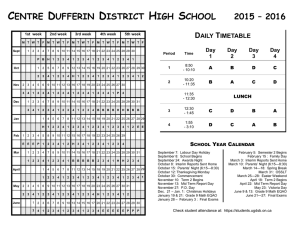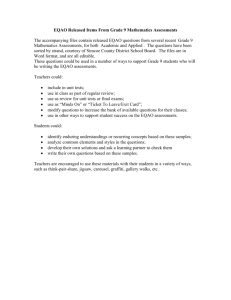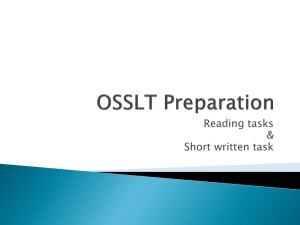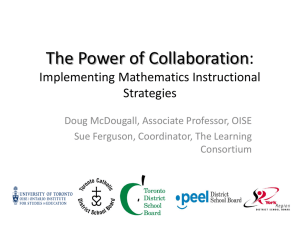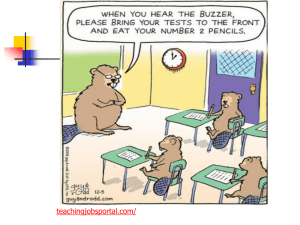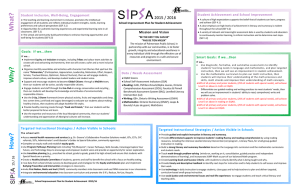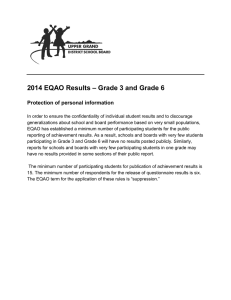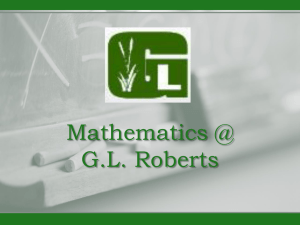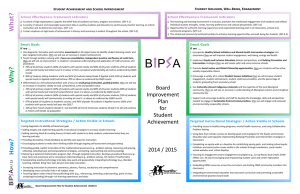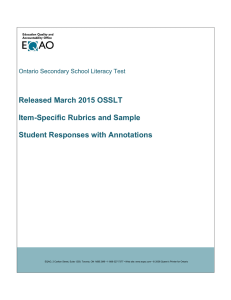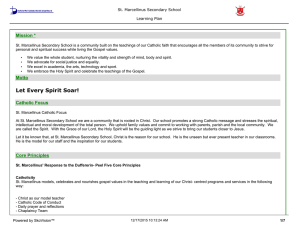S P A t? 2014 / 2015
advertisement
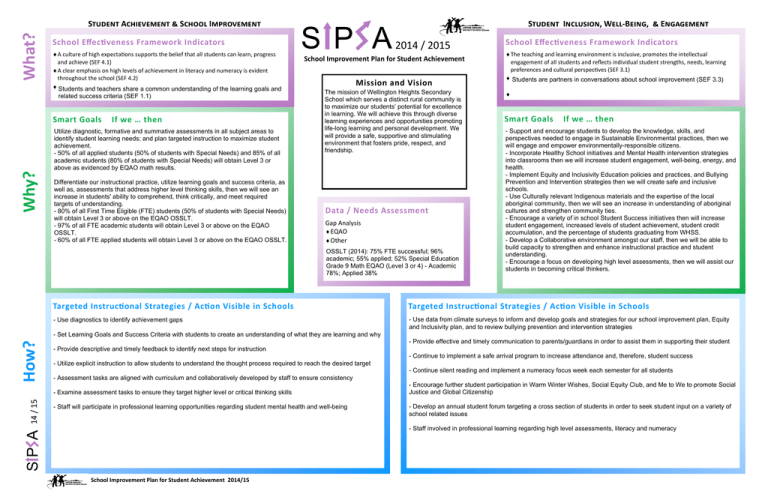
What? Student Achievement & School Improvement School Effectiveness Framework Indicators A culture of high expectations supports the belief that all students can learn, progress and achieve (SEF 4.1) A clear emphasis on high levels of achievement in literacy and numeracy is evident throughout the school (SEF 4.2) Students and teachers share a common understanding of the learning goals and related success criteria (SEF 1.1) Smart Goals If we … then Why? Utilize diagnostic, formative and summative assessments in all subject areas to identify student learning needs; and plan targeted instruction to maximize student achievement. - 50% of all applied students (50% of students with Special Needs) and 85% of all academic students (80% of students with Special Needs) will obtain Level 3 or above as evidenced by EQAO math results. Differentiate our instructional practice, utilize learning goals and success criteria, as well as, assessments that address higher level thinking skills, then we will see an increase in students' ability to comprehend, think critically, and meet required targets of understanding. - 80% of all First Time Eligible (FTE) students (50% of students with Special Needs) will obtain Level 3 or above on the EQAO OSSLT. - 97% of all FTE academic students will obtain Level 3 or above on the EQAO OSSLT. - 60% of all FTE applied students will obtain Level 3 or above on the EQAO OSSLT. S P A Student Inclusion, Well-Being, & Engagement 2014 / 2015 School Improvement Plan for Student Achievement Mission and Vision The mission of Wellington Heights Secondary School which serves a distinct rural community is to maximize our students’ potential for excellence in learning. We will achieve this through diverse learning experiences and opportunities promoting life-long learning and personal development. We will provide a safe, supportive and stimulating environment that fosters pride, respect, and friendship. Data / Needs Assessment Gap Analysis EQAO Other OSSLT (2014): 75% FTE successful; 96% academic; 55% applied; 52% Special Education Grade 9 Math EQAO (Level 3 or 4) - Academic 78%; Applied 38% School Effectiveness Framework Indicators The teaching and learning environment is inclusive, promotes the intellectual engagement of all students and reflects individual student strengths, needs, learning preferences and cultural perspectives (SEF 3.1) Students are partners in conversations about school improvement (SEF 3.3) Smart Goals If we … then - Support and encourage students to develop the knowledge, skills, and perspectives needed to engage in Sustainable Environmental practices, then we will engage and empower environmentally-responsible citizens. - Incorporate Healthy School initiatives and Mental Health intervention strategies into classrooms then we will increase student engagement, well-being, energy, and health. Student Wellbeing, Engagement, and Pathways - Implement Equity and Inclusivity Education policies and practices, and Bullying (from your SSA results) Prevention and Intervention strategies then we will create safe and inclusive schools. - Use Culturally relevant Indigenous materials and the expertise of the local aboriginal community, then we will see an increase in understanding of aboriginal cultures and strengthen community ties. - Encourage a variety of in school Student Success initiatives then will increase student engagement, increased levels of student achievement, student credit accumulation, and the percentage of students graduating from WHSS. - Develop a Collaborative environment amongst our staff, then we will be able to build capacity to strengthen and enhance instructional practice and student understanding. - Encourage a focus on developing high level assessments, then we will assist our students in becoming critical thinkers. Targeted Instructional Strategies / Action Visible in Schools Targeted Instructional Strategies / Action Visible in Schools - Use diagnostics to identify achievement gaps - Use data from climate surveys to inform and develop goals and strategies for our school improvement plan, Equity and Inclusivity plan, and to review bullying prevention and intervention strategies How? - Set Learning Goals and Success Criteria with students to create an understanding of what they are learning and why - Provide effective and timely communication to parents/guardians in order to assist them in supporting their student - Provide descriptive and timely feedback to identify next steps for instruction - Continue to implement a safe arrival program to increase attendance and, therefore, student success - Utilize explicit instruction to allow students to understand the thought process required to reach the desired target - Continue silent reading and implement a numeracy focus week each semester for all students - Assessment tasks are aligned with curriculum and collaboratively developed by staff to ensure consistency - Staff will participate in professional learning opportunities regarding student mental health and well-being - Encourage further student participation in Warm Winter Wishes, Social Equity Club, and Me to We to promote Social Justice and Global Citizenship - Develop an annual student forum targeting a cross section of students in order to seek student input on a variety of school related issues - Staff involved in professional learning regarding high level assessments, literacy and numeracy SP A 14 / 15 - Examine assessment tasks to ensure they target higher level or critical thinking skills School Improvement Plan for Student Achievement 2014/15
